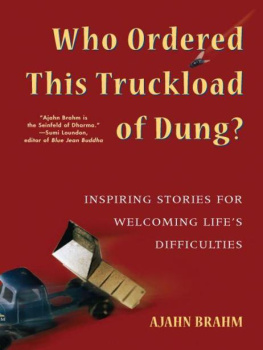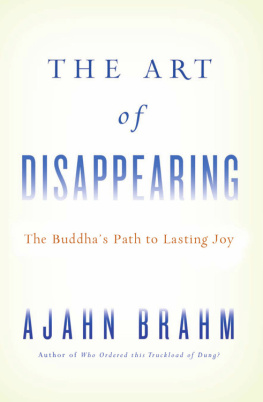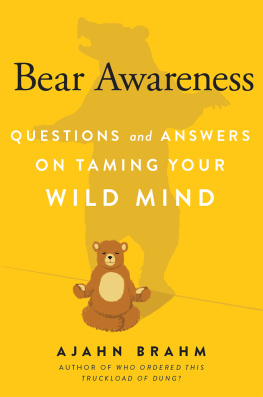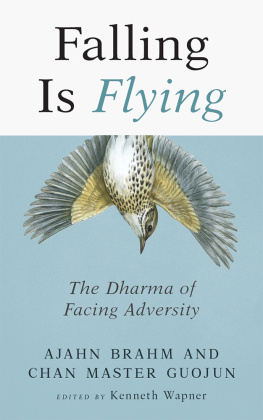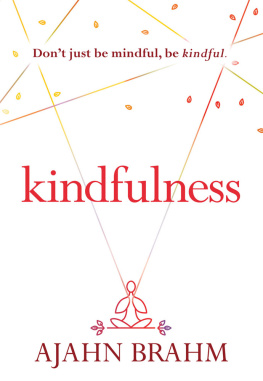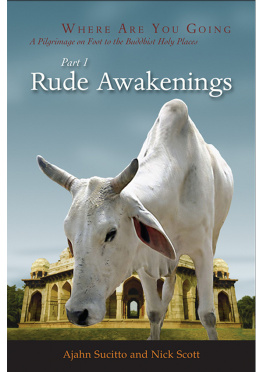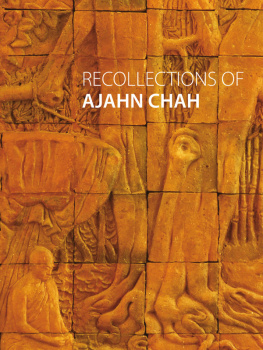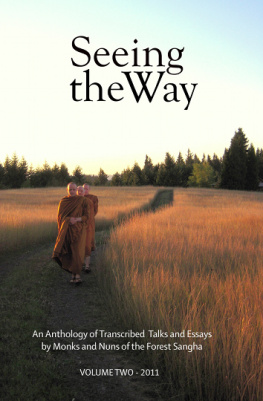Table of Contents
More praise for Ajahn Brahm and Who Ordered This Truckload of Dung?
Masterly storytelling and Dharma teaching, beautifully and effectively combined. The tales are at times hilarious, at times poignant; often both.
Larry Rosenberg, Senior Teacher, Insight Meditation Society and Cambridge Insight Meditation Center, and author of Breath by Breath
Ajahn Brahm is one teacher one can never be bored listening to. His talks on Buddhism in Malaysia and Singapore have always attracted record crowds. Newcomers to Buddhism are always fascinated by how easily he is able to explain difficult concepts in ordinary language the mind can grasp. [He has become] the great storyteller....What we have here is a collection of 108 stories and anecdotes comprising the best of Ajahn Brahms inspirational tales....Many stories in this volume are true-to-life tales that help us to develop a deeper understanding of mindfulness, compassion, and wisdom. Indeed, after reading the book, I believe we will all open the doors of our hearts to more goodness, kindness, and happiness.
Eastern Horizon
Whats remarkable about this collection is that whether he is relating a tale about painful emotions, difficult relationships (including with ourselves), or even going through airport security, he touches on the universals of human experience with wisdom and wit so that we may confront our foibles with disarmingly gentle humor.
Jean Smith, author of NOW! , and editor of 365 Zen
Ajahn Brahm is a happy, wise, and inspiring man. My Mum, a devout Anglican, says Who Ordered This Truckload of Dung? is so good she takes it to bed with her each night!
Rachel Green, communication specialist and Emotional Intelligence coach
Praise for Ajahn Brahms Mindfulness, Bliss, and Beyond
From the first word to the last, Mindfulness, Bliss, and Beyond is riveting, rollicking, and uncompromisingly real. Ajahn Brahms voice is utterly fresh, compelling and commanding. Readers seeking a sure guide to the bliss better than sex will find it in this wonderful book.
Glenn Wallis, translator of The Dhammapada: Verses on the Way
Ajahn Brahms first American book, Who Ordered this Truckload of Dung? introduced us to a British-born Theravada monk who teaches by telling entertaining life stories with a moral punchline. If that was the appetizer, this is the main course. Mindfulness, Bliss, and Beyond demonstrates that Ajahn Brahm is that rare meditator who has actually hadand can describethe profound meditation experiences outlined in the early Buddhist teachings.
Shambhala Sun
Like a broom through cobwebs, Ajahn Brahm here sweeps away the mysteries surrounding the [advanced] jhana [states]. Mindfulness, Bliss, and Beyond is salted with the illustrative, often witty life stories that Brahm is well known for, and he uses readily understandable language to explain what some teachers shy from. Finding this book is like finding an operators manual for ones practice. A bold book.
John Roberts, Buddhist Council of the Northwest
Most Buddhist writers are not often lighthearted or zesty, but the British-born Ajahn Brahm is a delightful exception. [] He is able to write about a variety of mental states and visualizations with precision and discrimination, drawing on his own experience. He is step-by-step systematic, which helps demystify what happens in meditation. Also useful is the specificity with which he describes the kinds of problems meditators encounter and what to do to resolve them. Meditation is difficult to teach on the page, but Brahm, who began his life as an academic at Cambridge, here fulfills his calling as a teacher.
Publishers Weekly
To my teacher, Ajahn Chah, who lived at peace,
To my fellow monks who remind me of the beauty of silence,
And to my father who taught me kindness.
Grant yourself a moment of peace,
and you will understand
how foolishly you have scurried about.
Learn to be silent,
and you will notice that
you have talked too much.
Be kind,
and you will realize that
your judgment of others was too severe.
acknowledgments
I wish to acknowledge Ron Storey for painstakingly typing up the first manuscript; my fellow monks for their guidance and help; and, lastly Magnolia Flora, for her advice and encouragement in the original Australian edition of this book.
preface
LIFE IS A SERIES of interwoven stories, not a set of concepts. Ideas are generalizations, always some distance from the truth. A story, with its array of meanings and richness of detail, is recognizably much closer to real life. That is why we relate more easily to stories than to abstract theories. We love a good yarn.
The stories in this book have been collected over the thirty years that I have lived as a monk in the forest tradition of Theravada Buddhism. For many centuries, Theravada has been the main vehicle of spirituality for the peoples of Thailand, Burma, Sri Lanka, Cambodia, and Laos. Now this form of Buddhism is growing in the Westand in the South (I live in Australia!).
I am often asked what the difference is between the major strands of BuddhismTheravada, Mahayana, Vajrayana, and Zen. The answer is that they are like identical cakes with four different icings: on the outside the traditions may look and taste different, but when you go deeply into them, you find the same tastethe taste of freedom. There was only one Buddhism in the beginning. The Buddha taught in northeast India around 2,600 years agothats a century before Socrates. He taught not only monks and nuns, but also many thousands of ordinary people: from rice farmers to street sweepers and even prostitutes. The wisdom of the Buddha did not come as a revelation from a supernatural being. It arose from the deepest of insights into the true nature of life.
The Buddhas teachings came from his heart, opened by deep meditation. As the Buddha famously said, It is in this fathom long body endowed with mind that the beginning and the end of this world are made known.
The Buddhas central teaching was the four noble truths. Rearranged from their usual order, these are
1 Happiness
2 The cause of happiness
3 The absence of happiness
4 The cause for such an absence
The stories in this book revolve around the second of these noble truths, the cause of happiness.
The Buddha would often teach using stories. My own teacher, the late Ajahn Chah of northeast Thailand, also taught using stories. After hearing one of Ajahn Chahs discourses, it was the stories I would remember most, especially the funny ones. Moreover, it was these stories that conveyed the deepest instructions about the path to inner happiness. The stories were the messengers carrying his teachings.
I have also used stories when teaching Buddhism and meditation in Australia, Singapore, and Malaysia for more than twenty years, and in this book I present some of what I feel are the best of these stories. Each story is intended to speak for itself, so I have added minimal commentary. Each one carries many levels of meaning, so the more you read them, the more truths are revealed.
May you enjoy reading these stories of true happiness as much as those who have heard them told. And may they help change your life for the better, just as they have for so many others.
Ajahn Brahm
Perth, May 2004



